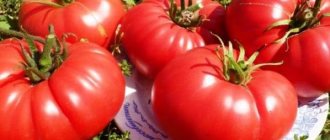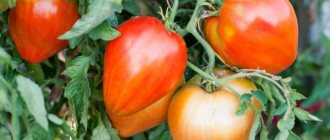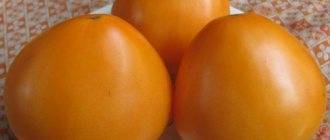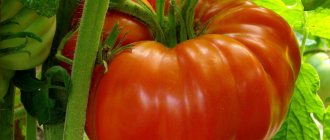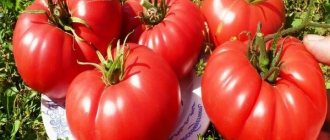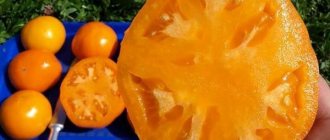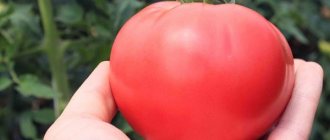The giant bull's heart is a favorite of farmers, a hero who has won love with huge fruits. Refers to the giant tomatoes in the garden beds. Leading in farming and gardening.
| Height | Landing location | Ripening time | Fruit color | Fruit size | Origin | Fruit shape |
| Tall | Greenhouse, Open ground | Mid-season | Pink | Large | Hybrid | Heart-shaped |
Basic data
Tomato "Bull's Heart", characteristics and description of the variety - refers to mid-season varieties. The first fruits ripen 120-130 days after emergence. The average yield per bush is 3.5-5 kg of tomatoes when grown in open ground and 8-12 kg in greenhouse conditions .
The plant is powerful, spreading, with few leaves. The bushes are tall, not standard, of determinate type. They stop growing after the formation of 5-6 bunches of fruit. The length of the stems reaches 1.5-1.8 m. The first ovary is formed above the 8th or 9th leaf, subsequent clusters with fruits are formed after 1-2 leaves. Up to 5 fruits ripen on each cluster.
A feature of the variety is the presence of fruits of different shapes and sizes on one plant. The largest tomatoes (weighing 300-500 g) ripen in the lower part of the bush. The upper fruits are much smaller and weigh no more than 100-150 grams .
The variety's disease resistance is average. Particularly susceptible to late blight infection. The soils for growing this variety are preferably light and fertile. Bull's Heart tomatoes are quite transportable. Crop losses during long-distance transportation do not exceed 5%.
Description and characteristics of tomato Bull's heart, reviews, photos
The Oxheart tomato is the most famous and widespread variety among gardeners with large heart-shaped fruits with a classic tomato taste.
A very popular, medium-late (120-125 days period from germination to the beginning of ripening), medium-sized, productive variety of salad tomatoes for greenhouses and open ground. In the middle zone, it is recommended to grow it in a greenhouse.
The bush is up to 1.5 meters high in the greenhouse, slightly lower in the greenhouse. The leaf is medium size, regular type, green. The inflorescence is simple. The first inflorescence is planted above the 8-9th leaf, then every 1-2 leaves.
The plant needs staking to a support and pinching. The manufacturer recommends forming the plant into 2 stems when grown in a greenhouse and 3 stems when grown in open ground. In the first case, you need to leave the stepson under the first flower cluster - this will be the second stem. When forming 3 stems, leave 1 stepson under the first flower cluster, and the second one immediately above it - in total, together with the main stem, you get 3 stems.
Basic qualities of fruits
The fruits are heart-shaped, large, of medium density, rich red in color at maturity, weighing 200-400 grams (up to 600 g), fleshy and very tasty. This tomato has exactly that real tomato taste with a slight sourness, which has been recognized as a “classic” for many years and with which the taste of other heart-shaped tomatoes is compared. These tomatoes are good for fresh consumption, making juices and sauces. They are poorly stored, it is advisable to use them immediately after removal.
Productivity of tomato Bull's heart : 8-12 kg of fruits per 1 sq. meters of plantings (subject to compliance with agricultural technology, the presence of watering and fertilizing).
If you want to get fruits weighing over 500 g, form the plant into 1 stem. The harvest in this case will remain the same in weight, but there will be fewer fruits and they will be larger.
A site about tomato varieties with truthful reviews from gardeners - Tomatland.
This is a natural variety of tomato. Therefore, we recommend taking seeds from a ripe fruit and using them for planting in subsequent seasons.
Description of fruits
The appearance and size of Bull's Heart tomatoes are very diverse. Most tomatoes have a fairly regular heart shape. The weight of individual tomatoes (with proper agricultural practices) can reach 600-800 grams; cases have been recorded when the weight of one tomato was close to 1 kg.
The color of tomatoes is rich red. The peel is thin and easily separated from the pulp. The inside of the fruit is fleshy, dense, low in water, with a high content of dry matter. There are practically no veins.
There are few seed chambers inside the fruit (4-5 pieces), they are small and located closer to the edge of the fruit. The chambers are poorly filled with seeds. The taste of tomatoes is excellent . The increased sugar content in the fruit pulp gives them a unique sweetness. A slight sourness emphasizes the exquisite taste of tomatoes.
The keeping quality of the tomatoes is good. In a cool place (refrigerator or cellar) they do not lose their shape and retain their taste for a couple of weeks. With longer storage, the fruits become soft and are suitable only for heat treatment.
Fruit shape and quality
Oxheart tomatoes are so named because of the special shape of the fruit. They really resemble a heart, slightly pointed at the bottom. On average, the weight of large specimens reaches 600 grams. However, there is plenty of evidence from gardeners who received much larger fruits – up to 1 kg!
The skin of tomatoes is thin, bright pink. The pulp is dense, with a small water content, sugary, practically without fiber. The seed chambers are small and poorly filled.
The taste of "Bull's Heart" is excellent. An excellent balance of sweetness and slight sourness makes them an excellent option for salads and snacks.
In cooking, the variety is most often used fresh. A variety of salads are prepared from tomatoes, they decorate sandwiches, pizza, etc. For canning, tomatoes must be chopped. They also make excellent tomato sauces and pastes.
Photo
See photos of the “Bull’s Heart” tomato variety below:
Characteristics and description of the variety
The “Bull's Heart” tomatoes, beloved by gardeners, are a mid-season variety; the first fruits can be harvested 120-140 days after germination. The bushes are medium-branched, tall, and, depending on conditions, can have a length of 1.4 to 1.6 meters. The stems are substantial, fleshy, pubescent, dark green in color. The plants grow few leaves; they are large and have a simplified shape (somewhat similar to potato tops). Refers to fleshy varieties of tomatoes.
If the bushes can still be confused with another variety, then even a beginner in plant growing can distinguish the fruits. They are characteristically heart-shaped with well-defined longitudinal depressions. The color can be absolutely any, from light pink to brown-black. The main quality of these tomatoes is their size; they can be up to 20 cm in diameter, and the weight of the largest fruits reaches 700-800 grams. The skin of the vegetable is thin and easily separates from the pulp. The inside of the tomato is pinkish, slightly juicy and sweet, the veining is weak and insignificant. There are from 4 to 6 seed chambers, they are located directly under the skin near the very walls of the fruit. Other varieties of beef tomatoes, including Bull's Heart, are described in this material.
“Bull’s heart” is the name given to a group of varieties that differ in appearance. It is by the color of the fruit that different subspecies are distinguished: Ox heart pink, orange, black, yellow, red and white. The darker the color, the sweeter the tomatoes.
Features of agricultural technology
The variety is quite capricious to grow. Only compliance with certain requirements for agricultural technology allows you to get a good harvest.
Basic activities for growing "Bull's Heart" tomatoes:
- On one square per meter, no more than 3-4 bushes are planted according to the 50x50 pattern.
- Correct formation of the bush. Leave one or two stems (the second one is from the first stepson). The remaining shoots are removed. They also tear off all the lower foliage up to the first cluster with the ovary.
- To obtain the best harvest, no more than 8 clusters with ovaries are left on one bush. A couple of leaves are left above the last cluster and the top is pinched.
- Timely tying to the support of the plant trunk is necessary as it grows. In addition to the main stem, if necessary, the brushes with tomatoes are also fixed.
- It is preferable to choose soil that is light and fertile, with a high content of nutrients.
- The plants are fed with mineral and organic fertilizers every 10-15 days.
Variety varieties
Due to its great popularity, the tomato has many varieties that have similar characteristics but differ in color.
Pink
These include the following subspecies of the variety:
- Pink. A mid-late giant, the weight of the fruit reaches 600 g. Planting is carried out both in open ground and in a greenhouse. The main feature is the location on one bush of both large and very small fruits (up to 100 g). Does not apply to shelf-stable varieties: the shelf life of ripe tomatoes does not exceed 10 days;
- Abakanskoe. In a temperate continental climate, it is advisable to grow in a greenhouse. Needs a garter to a very strong support. It is better to form into one stem;
- Michael's Pink. A very rare early subspecies. The fruit looks like a giant heart;
- Babushkino. An indeterminate hybrid, the height of the bush can reach up to 160 cm. The weight of tomatoes reaches 0.5 kg;
- Joe pink. The weight of the fruit can exceed 1 kg. Carpal plant. High yield;
- Chernigovskoe. A sweet, fleshy tomato with an average ripening period, grown in open ground and in greenhouses;
- Favorite holiday. Bred by breeders from Siberia. Ideal for planting in areas of central Russia. Determinate plant. The weight of the fruit can reach 1.3 kg;
- Fish Lake. The family subspecies is native to Canada. Has a high sugar content. Average weight – 350-600 g. In a temperate continental climate, it is advisable to grow tomatoes in greenhouses;
- Compact A low-growing subspecies that does not require powerful support. Tomatoes are characterized by early ripening - already 100 days after the sprouts appear, fruits are formed.
The shades of this type of tomato vary from bright pink to pink-raspberry.
Reds
Subspecies that have red fruits of varying intensities include:
- Minusinsk Exhibition. Bright red tomato, reaching a weight of 0.6 kg. Virtually no seeds;
- Striped. The carmine-red skin has dark stripes. Bushes grow up to 170 cm. When growing, they need a garter;
- German Homer. A very popular mid-season hybrid tomato. In 2014, it was recognized as the largest-fruited: fruit weight reaches 1.5 kg. The peculiarity of the tomato is the presence of small ribs;
- French. The plant is easy to care for, resistant to diseases and lack of moisture;
- Linney. Medium-sized, mid-early subspecies. A tomato turns red when ripe. Contains a small amount of seeds. The weight of the fetus reaches 680 g.
Yellow
There are also yellow subspecies of this variety:
- Dawson's Russian. Amateur subspecies. Fruit weight is from 0.8 to 1 kg. They are yellow with red veins;
- Golden. The hybrid was obtained by artificial pollination of 2 varieties, which is marked f1. Late ripening plant. The fruits are dense and smooth, weight - from 240 to 280 g;
- Orange. New. A tomato with the shortest growing season (115 days pass from the moment sprouts appear to full ripening) and unlimited growth of the bush (its height reaches 180 cm). The color of a ripe vegetable is yellow-orange, weight – from 150 to 400 g.
The yellow varieties have an unusual and beautiful appearance, and the fruits have a wonderful taste.
White
The bush of the White Bull's Heart variety can grow up to 1.5-2 m in height. When ripe, the tomato becomes white-yellow (less often pinkish). The pulp is yellow.
Most often, a tomato weighs from 200 to 300 g, some “giants” grow up to 600-800 g. Recommended for baby food due to its hypoallergenicity. The crop needs staking due to its high growth.
Black
The Oxheart black tomato has a brown-burgundy peel color with a black tint. The tall crop (reaching more than 1.5 m) produces heart-shaped fruits weighing from 350 to 600 g. It is distinguished by a dense, non-cracking peel, which guarantees good transportability and preservation of its presentation for a long time.
One bunch will grow up to 7 tomatoes. The harvest is harvested quite late - in August and September.
Raspberry
The fruits reach a weight of more than 500 grams
The Raspberry subspecies is distinguished by its increased resistance to various climatic conditions: it is able to grow in the north of Russia, in the central regions of the country (Moscow region), and in the southern regions. The tomatoes are smooth, heart-shaped, raspberry in color, weighing 350-600 g.
The bush is spreading, consists of several stems. Up to 4 tomatoes are tied on one brush.
Diseases: prevention
The main threat to tomatoes is late blight. In order to prevent the disease during the growing season of plants, the bushes are treated twice with fungicides. Water the “Ox Heart” tomatoes directly under the root, avoiding moisture getting on the leaves.
For the same purpose, the greenhouse is regularly ventilated to prevent the appearance of moisture concentrate on the walls of the shelter. At the first signs of the disease appearing on the bush, remove all affected leaves and fruits. They are taken outside the site and burned.
Features of the variety
Ox heart has a number of advantages over other varieties, as well as several main features:
- Fruits of different sizes grow on one bush. As a rule, the closer to the ground, the larger the fruit; smaller and oblong tomatoes are formed at the top.
- They have high shelf life , but are not suitable for conservation due to their size. In a cool place it can retain its taste for up to 2 weeks.
- They are related to salad varieties of tomatoes and are mainly grown for fresh consumption. But it is often used for stewing as part of complex dishes.
Thanks to the breeding of tomato hybrids in laboratory conditions, it is possible to observe the behavior of plants, as well as instill in them the necessary qualities
Country of origin, regions of distribution
The variety "Bull's Heart" was bred relatively recently, in 2003, by breeding scientists. In the same year, Rosselkhoznadzor included it in the register of biotechnology and genetic engineering products allowed for cultivation in Russia. It is known that these tomatoes were obtained by crossing southern varieties that have the most significant qualities for farmers.
When growing crossed tomatoes in experimental greenhouses, observation is carried out directly by breeding scientists
Later, long modifications made it possible to adapt the resulting hybrid for colder regions. As a result, “Bull’s Heart” was adapted for cultivation in open ground in the warm climate of southern and central Russia. For the cold temperate zone, only the greenhouse method of growing tomatoes is acceptable. Server regions characterized by short daylight hours are least suitable.
Advantages and disadvantages
The main advantages of ox heart tomatoes include:
- high yield , sometimes reaching more than 3.5-4 kg per bush;
This tomato variety is not suitable for preservation due to its thin skin and large size. It just won't fit into the neck of the jar.
- transportability : during transportation, as a rule, no more than 7-10% of tomatoes are damaged;
- taste data , due to the large amount of sugars contained, specimens of this variety are very sweet, with pronounced sourness;
- the need to buy planting material once , then you can grow the seeds yourself.
In addition to the undeniable qualities of this hybrid, a number of its disadvantages can be identified. Because of this, “Bull's Heart” is rarely used in large-scale production (it is simply not profitable and labor-intensive). The variety does not tolerate any diseases, and various insect pests are always ready to feast on its fruits.
Advantages and disadvantages
The main advantage of "Bull's Heart" over other varieties of tomatoes is the unique taste of the fruit. Fleshy pulp with a pleasant sweet-sour taste makes these tomatoes the kings of salads. It is impossible not to note the productivity of the variety. A couple of tomato bushes can feed a large family for several months. And the size of the tomatoes will delight the heart of any gardener.
Another factor that gives this variety an advantage over its peers is the ability to grow crops from its own seeds. Having purchased planting material once, you can subsequently collect seeds from ripened fruits. The main disadvantage of this variety is the need for constant care of the plants. They do not grow on their own; they must be cared for and cherished.
Features of growing tomato Ox heart, planting and care
We recommend sowing the seeds of this tomato for seedlings 60-65 days before the intended planting in the ground. Tomato shoots appear 5-7 days after sowing with dry seeds; when planted with sprouted seeds - after 2-4 days. From the moment of germination, plants need a lot of light, so we recommend planting this variety in March, when there is already a lot of spring sun and the seedlings will have enough of it for full development. Those who sow tomatoes for seedlings in February risk getting elongated plants for planting, and this will complicate their transportation to the planting site and further survival in the soil. Typically, elongated seedlings are planted “lying down”, placing most of the stem horizontally underground to a depth of 10-15 cm.
When planting seedlings in a permanent place, for the full development of plants, per 1 sq. It is recommended to place no more than 3 plants per meter of land. Planting pattern : 50 x 40 cm.
The variety responds well to fertilizing during the growing season. Usually during the summer it requires 2-3 feedings with complex mineral fertilizer.
Caring for tomatoes after planting consists of timely watering, pinching, removing weeds, fertilizing with complex mineral fertilizer and preventive measures to protect the crop from diseases and pests. It is advisable to water tomato plants with warm water.
Value of the variety : large-fruited, excellent taste of the fruit.
Features of cultivation and storage
To obtain a rich harvest, fertilizing is carried out, starting with growing seedlings. Use bird droppings or humus in a dilution of 1:10, potassium sulfate, superphosphate.
During fruiting, saltpeter, potassium chloride, and superphosphate are added. Used in the form of solutions for irrigation.
Form into 1-2 stems, shoot once every 10 days.
Ripe tomatoes are characterized by good transportability. Shelf life is average - up to 2 weeks in cool conditions, without drafts, humidity and sun.
